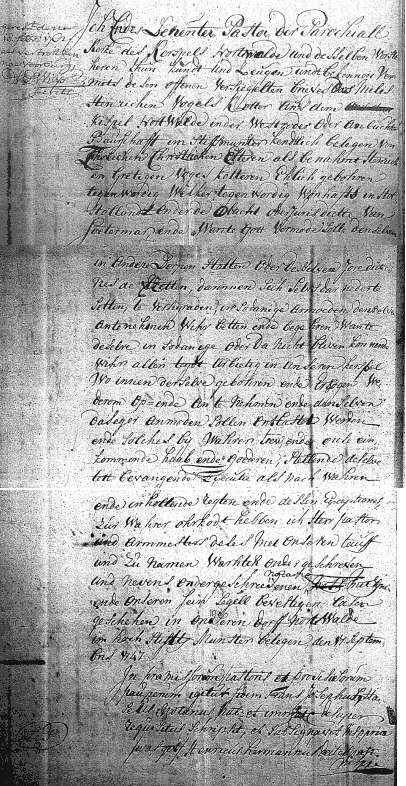
18 febr 1762
als vertroken
naar Voorburg
- In
pramisforum pastoris et provisieforum paupenim igitur fidem Frans Josephus
Haselt, notarius pub et immate deluper reguisitus schrifzsel, et subsignavit
insppria pualges Henricus Hermannus Deitespaft Nippe
The beginning
The story of the Koot family begins when
Milis Henrichen Vogels Kotter, son of Henrich and Gretigen Voges Kotteren,
moved from Nordwalde to Wassenaar in the western part of Holland. Nortwalde
today is situated in Germany in the environment of Osnabrück. During
that time it was a part of the properties of the bishop of Utrecht. Utrecht
belonged to the 'United Netherlands' as well as Holland did.
To move from one area to another, or even
from one town to another, was not too simple. One had to prove to have
or to earn money enough to survive for one or two years, afraid to be an
economical load for the community. There were no social funds in that time.
Mostly the church of the place of departure gave the guarantee, in the
form of a written document, which the people could fall back on, in economical
sense. The guarantee of Milis Henrichen Vogels Kotter, called a 'borgbrief',
is reproduced here. It is written in a mix of Dutch and German and ends
in latin.
The origin of the surname 'Voges Kotteren'
is unknown. The name changed from ' Vogels Kotter', 'Voges Kotteren', 'Vogelskoot'
to 'Koot'. Surnames were not fixed. This was established later, during
the occupation of France (Napoleon) around 1810.
A farmers wedding party in 1903
It was a traditional wedding on the 6th of May 1903 between Huibertus Adrianus Koot and Cornelia Geertruida van Leeuwen. Looking to the official wedding photograph taken on that day, we have a marvelous moment of group of important Cathlic farmer families from that period of time. The photograph gives an excellent condensed overview of the connections between the families Koot, van Leeuwen, Hooijmans and van der Ham. It is a significant representation from the most important farms in the neighborhood. And additional we see some nice examples of traditional costumes of the province Zuid Holland.
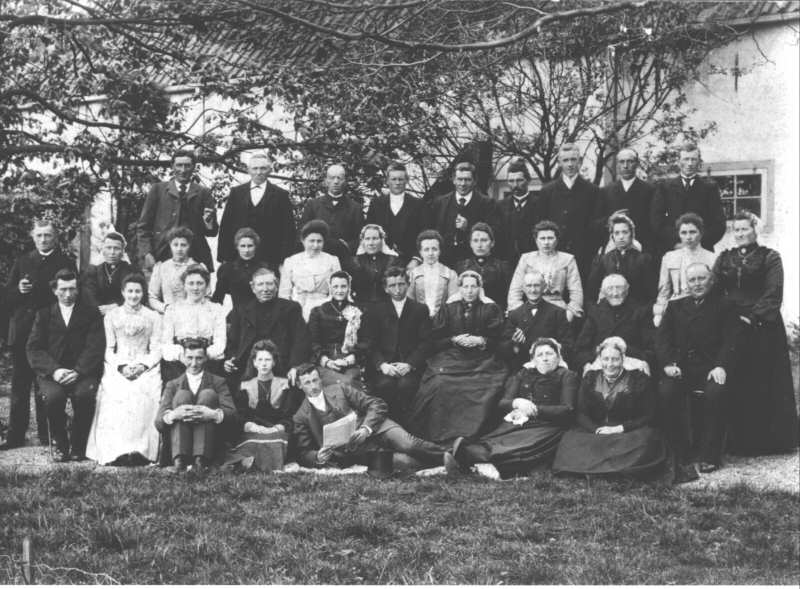 |
click on the picture to enlarge it
|
|
On this picture we see: 1: ? 2: Johannes Cornelis Koot (1856-1939) 3: ? 4: Willem Johannes van der Ham (1870-) 5: Hendricus Adrianus Koot (1868-1939) 6: Petrus Johannes Koot (1871-1946) 7: Johannes van Noort 8: Cornelis Koot (1861-1906) 9: Leonardus Johannes Hooymans (1865-1928) 10: Adrianus Kortekaas (1864-) 11: Jacoba Bergman (1833-1921) 12: Archangela Maria van Leeuwen (1879-1943) 13: Johanna Elisabeth Mooyman (1870-1961) 14: Maria van Leeuwen 15: Maria Petronella Hooymans (1859-1949) 16: Polien van Noort 17: Adriana Maria Koot (1875-1936) 18: ? |
19: Johanna van der Post (1862-1911) 20: Johanna Maria Hooymans (1874-1961) 21: Anna Maria Arkesteijn (1863-1933) 22: Cornelis Hendricus Koot (1866-1906) 23: Maria Petronella van Leeuwen (1878-1959) 24: Johanna Maria Koot (1880-1952) 25: Cornelis Koot (1827-1909) 26: Cornelia Geertruida van Leeuwen (1877-1956) 27: Huibertus Adrianus Koot (1870-1952) 28: Jacoba Maria Hooymans (1846-1927) 29: Adrianus van Leeuwen (1842-1929) 30: Cornelis Johannes Koot (1855-1915) 31: Petrus van Leeuwen 32: Johannes van Leeuwen (1881-) 33: ? girl friend of 34, not his later wife 34: Leonardus Adrianus van Leeuwen (1882-) 35: ? so-called Zwarte Sjaan 36: Elisabeth Schilperoort (1864-1938) |
Besides the bridal couple Huibertus Koot and Cornelia van Leeuwen (27 and 26) the groom's father Cornelis Koot (25), farmer on the farmhouse Oost Duivensteijn untill that date. On the occasion of the marriage in 1903 his son Huibertus took over this farm. We see also the sister of the groom Adriana (17) with her husband Willem van der Ham (4) living on the Oostenburg farm.
Cornelis Koot, the groom's half-brother (30) with his second wife Elisabeth Schilperoort (36) farming on Reedenburg are on the picture as well. More distant in the family is cousin Cornelis Koot (8) with his wife Maria Hooymans (15) governing the farm Essesteijn and on the party as well.
The farmers Koot were not settled in Voorburg alone. We see Cornelis Koot (22) and his wife Johanna van der Post (19) living next door Oost Duivensteijn in Leidschendam where they had a farm (a riding school to-day). Of course there were members of the family on the wedding party not having a farm. Hendricus Koot (5) is milkman in The Hague and his wife is probably not present to keep the dairy.
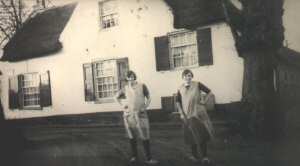
Oost Duivensteijn about1930 with Elisabeth Cornelia (1914) and Johanna Maria (1908) Koot. |
The couple continuous the farm Oost Duivensteijn
and is the second generation Koot on this palce.They get 9 children.
Four of them died very soon. The eldest son Adrianus Johannes Koot
shall, with his wife Maria Barbara van Haaster, continue the farm in
1936. Typical for the family the eldest daughter Jacoba Maria Koot
married Arnoldus Cornelis van der Maarel in 1932 who is farming on
the Hoeve Nabij in Voorburg (Westvlietweg,
incorporated by Leidschendam in 1938) until they leave in 1955 to start
a chicken farm in Apeldoorn.
Life was sometimes hard on a farm far from the village. The children of this Catholic family must go to a Catholic school, operated by nuns opposite the St. Martinus church. And that was a twenty minutes walk. It was quite normal to have diner at noon, so the children went home to eat and went back very quickly, good weather or bad. |
Each farm had some personnel, sometimes living on the farm. Farm laborers and domestic staff was quite normal during that time. But the children needed to help with making cheese and that kind of work as well.
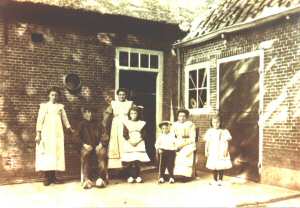 |
Oost Duivensteijn begin 1914 Left to right: unknown girl for domestic work, Huibertus (father), Cornelia (mother), Jacoba (Co, 1906), Adrianus (Arie, 1909), Anna van der Tocht (domestic), Johanna (Jo, 1908)
|
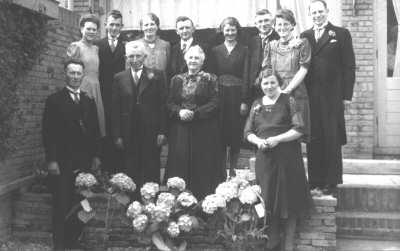 |
The picture on the right is nade in 1943, 40 years later and the couple from above is surrounded by all children and their partners. Grandchildren are not on this photograph. Picture is taken in the back yard of their house in Voorburg.
Farmers and milkmen
As said in the previous chapter there were may farms managed by the family Koot. Wassenaar, Voorburg, Veur (Stompwijk) en later also further away one can see farms from the family Koot. Besides the farmers, the Koot family has also many milkmen.
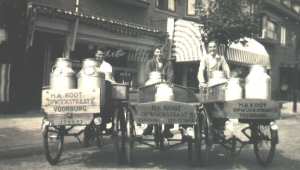 |
Huibertus Adrianus Koot (1870-1952) bought a milk shop in 1932 (Opwijckstraat, Voorburg) operated by his son Cornelus Leonardus (1917) and his daughter Elisabeth Cornelia (1914) with the name H.A. Koot (left).
After the marriage of his son he took over the shop and started for his own. From now it is C.L. Koot (right). |
|